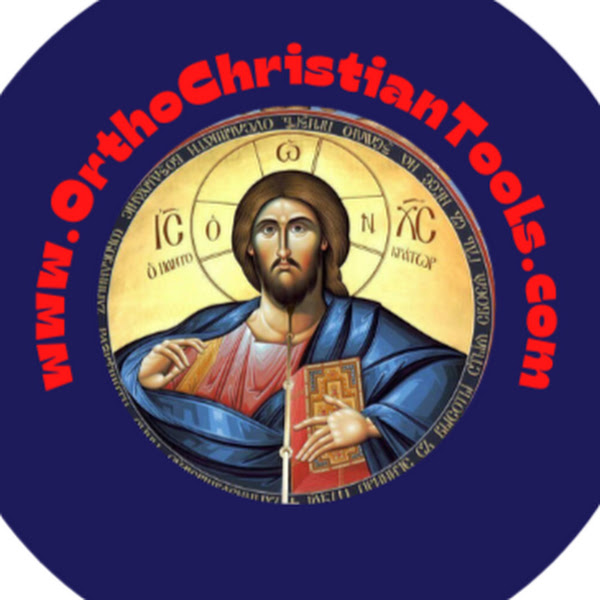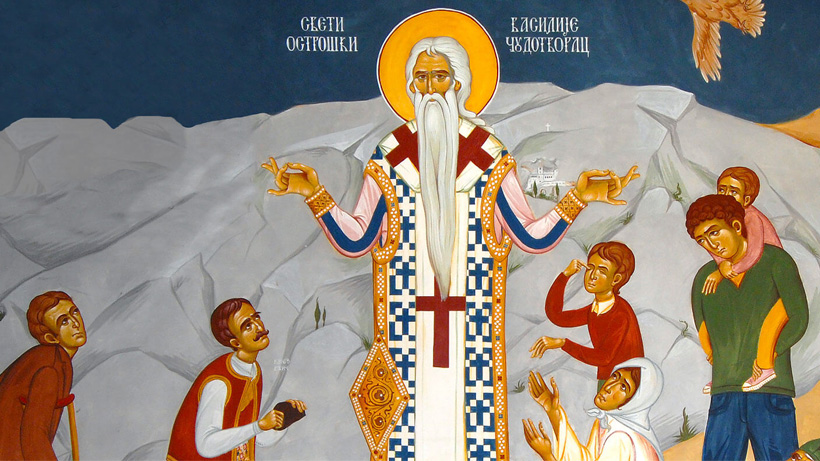Introduction
In every nation and in every age, the Lord grants His Church holy saints who illuminate, sanctify, and guide His faithful people on their earthly journey toward the Heavenly Kingdom. Among the Serbian people, ever since their conversion to Christ, God has continuously bestowed saints through whom He is glorified and His truth is witnessed.
One such saint is Saint Basil of Ostrog, the wonderworker and Metropolitan of Zahumlje. His life was marked by unwavering faith, tireless pastoral work, and miraculous healings that continue to this day. His feast day is celebrated on May 12 drawing thousands of pilgrims to his relics in the Serbian Monastery of Ostrog, Montenegro.
This blog post explores his life, struggles, and the countless miracles attributed to his intercession, offering inspiration and hope to all who seek divine grace.
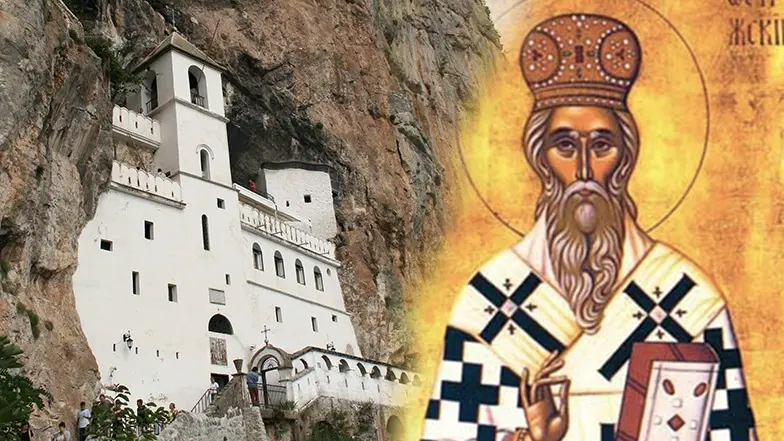
Early Life Under Turkish Oppression
Saint Basil, born Stojan Jovanović on December 28, 1610, in the village of Mrkonjići in Trebinje (modern-day Herzegovina), entered the world during one of the darkest periods of Serbian history. The Ottoman Turks ruled with brutal oppression, imposing heavy taxes, forced conversions to Islam, and violent persecution on the Orthodox Christian population.
From a young age, Stojan witnessed the suffering of his people. His devout parents, Petar and Anastasija Jovanović, raised him in the Orthodox faith despite the constant threat of Turkish violence. They instilled in him deep piety, teaching him to trust in God even amid hardship.
A Boyhood Marked by Faith and Danger
As a child, Stojan was known for his exceptional devotion. While other boys played, he often retreated to pray, fast, and attend church services. His love for God made him a target of hostility from local poturice (Islamic converts) and Turkish authorities, who despised Christian zeal.
One day, the persecution grew so severe that his parents feared for his life. Knowing that the Turks often kidnapped Christian children to raise them as Muslims or enslave them, they made the difficult decision to send him away for safety.
Sanctuary in the Monastery of Zavala
To protect him from the Turks and nurture his spiritual growth, Stojan’s parents sent him to the Serbian Monastery of Zavala, dedicated to the Presentation of the Theotokos, where his uncle, Hieromonk Seraphim, served as a monk.
At Zavala, young Stojan immersed himself in prayer, Scripture, and the writings of the Church Fathers. The monastery became his spiritual fortress, shielding him from the chaos of Ottoman rule while deepening his love for Christ.
Later, seeking greater ascetic struggle, he moved to the Monastery of Tvrdoš, the seat of the Trebinje Diocese, where he embraced the monastic life, taking the name Basil in honor of St. Basil the Great.

Defending Orthodoxy Against Latin Propaganda
During the 17th century, the Jesuits, sent by the Pope, aggressively sought to convert Orthodox Christians in Herzegovina and Montenegro to Catholicism, exploiting the suffering of the people under Ottoman rule.
Saint Basil, recognizing the danger, urged Metropolitan Mardarije of Cetinje to resist this Uniate (Eastern Catholic) propaganda. However, the metropolitan was passive, leading Basil to take a bold stand. His fervent defense of Orthodoxy earned him the title “Zealot of Orthodoxy.”
When persecution intensified, he traveled to Russia, returning with liturgical books, vestments, and funds to restore churches and support the faithful.
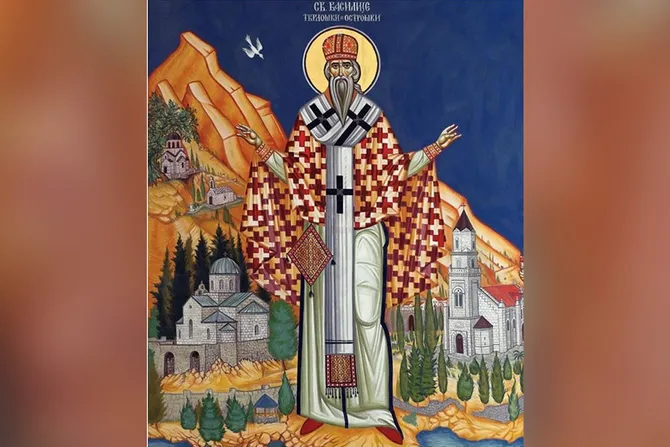
Episcopal Service and Exile to Ostrog
In 1638, Patriarch Paisios of Peć consecrated Basil as Metropolitan of Trebinye, overseeing the Zahumlye Diocese. Despite Turkish oppression, he tirelessly visited parishes, celebrated divine services, and performed miracles of healing.
However, increasing persecution forced him to seek refuge in Ostrog, a remote mountain monastery. There, he lived in a cave, continuing his ascetic struggles while guiding his flock. He restored the Monastery of Ostrog, building the Church of the Holy Cross and gathering a brotherhood of monks.
For 15 years, he endured hardships—fasting, praying, and working miracles—while shepherding his people spiritually.
Miracles During His Lifetime
Even before his repose, Saint Basil was revered as a living saint. Many witnessed his gift of clairvoyance and miraculous healings.
Prophecy Against Oppression: When a local nobleman, Knez Raič, persecuted the monastery, Basil prophesied his sons would perish. After this came true, Raič repented, and Basil assured him God would bless him with new heirs—which also happened.
Healing the Sick: Countless afflicted people came to him, receiving cures through prayer.

Repose and Posthumous Miracles
Saint Basil reposed peacefully on April 29, 1671. Seven years later, he appeared in a dream to Abbot Raphael of St. Luke’s Monastery, commanding him to open his grave. When the abbot hesitated, Basil appeared again, burning him with incense embers as a sign.
Upon opening the tomb, the monks found his body incorrupt and fragrant, confirming his sanctity. Since then, countless miracles have occurred at his relics, drawing pilgrims of all faiths.
Recorded Miracles of Saint Basil
Atheist Healed of Paralysis – A paralyzed man, who refused to visit Ostrog, dreamed of Saint Basil inviting him. After reluctantly going, he was completely healed and even named his son Vasilije (Basil) in gratitude.
Woman Cured of Stomach Ulcer – A man suffering from an ulcer had a vision of Basil leading him to his relics. After praying there, he was miraculously healed.
Muslim Woman Freed from Demonic Torment – Fatima, suffering violent convulsions for years, was brought to Ostrog. After prayers at his relics, she was freed and converted to Christianity.
Miraculous Protection in War – During WWII, a German shell struck Ostrog’s church but miraculously did not explode, sparing the monastery.
Healing of Mental Illness – A girl possessed by insanity was brought bound to Ostrog. After prayers, she was freed and lived a normal life.
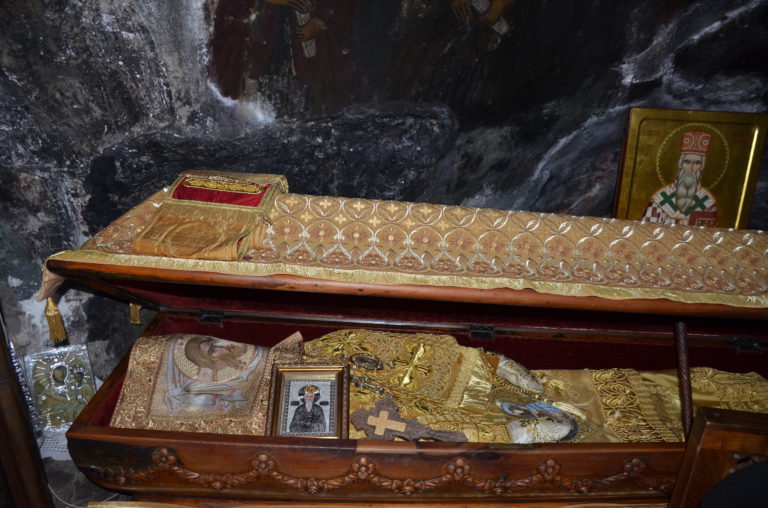
Veneration and Legacy
Today, Ostrog Monastery is one of the most visited pilgrimage sites in the Balkans. Pilgrims climb on foot (sometimes on their knees) to venerate Saint Basil’s relics, seeking:
Healing from physical and mental illnesses
Deliverance from addiction and despair
Blessings for marriage, children, and family
Many leave votive offerings—crutches, chains, and written testimonies—attesting to miracles received.
Churches Dedicated to Saint Basil
Church of St. Basil in Nikšić
St. Basil’s Hospital in Belgrade
Numerous chapels worldwide

Conclusion: A Saint for All People
Saint Basil of Ostrog remains a living testament to God’s mercy, transcending ethnic and religious boundaries. His relics continue to radiate grace, offering hope to the suffering and affirming the power of faith.
“Through the prayers of our holy father Basil, wonderworker of Ostrog, may the Lord have mercy on us and save us. Amen!”
Plan Your Pilgrimage
Feast Day: May 12 (April 29, Old Calendar)
Location: Ostrog Monastery, Montenegro
Miraculous Relics: Enshrined in the Upper Monastery’s Church of the Presentation
Whether you seek healing, spiritual renewal, or a deeper connection to Orthodox tradition, Saint Basil of Ostrog stands ready to intercede.
Have you experienced a miracle through Saint Basil’s prayers? Share your testimony in the comments below!
